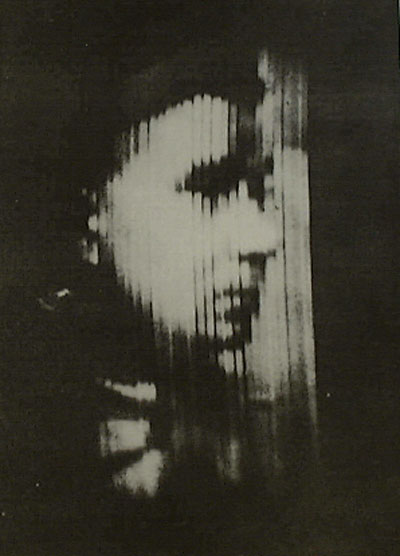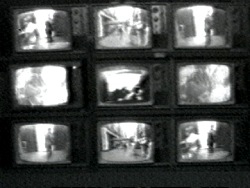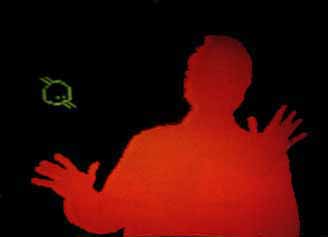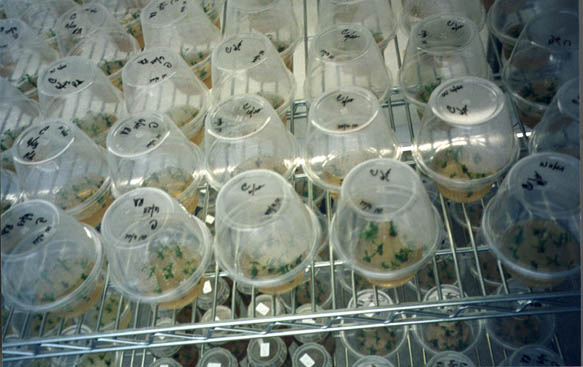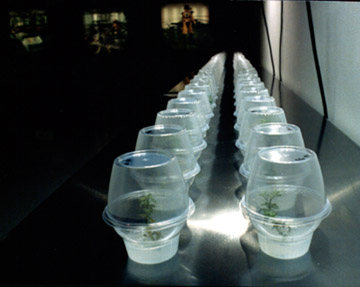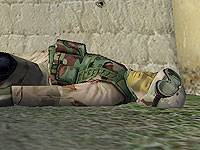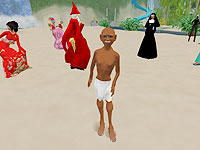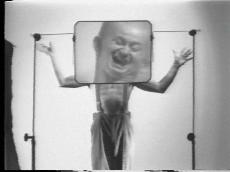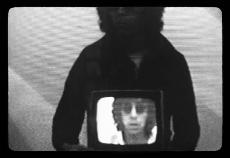Digital art timeline
This page is for students in the School of Art theory course "Immersed in Technology" to build our own idiosyncratic timeline, reflecting what we think is important in digital art history.
Contents
- 1 pre-1900
- 2 1900-1930
- 3 1930-1960
- 4 1960-1990
- 4.1 1990: Release of Photoshop 1.0
- 4.2 1963: Wolf Vostell, Burying T.V
- 4.3 1964: Charles Csuri
- 4.4 1965: Sony Portapack
- 4.5 1969: TV as a Creative Medium
- 4.6 1969: Seek
- 4.7 1969: Videoplace
- 4.8 1969: ARPANET
- 4.9 1973: Nam June Paik, Global Grove
- 4.10 1975: Media Burn-Ant Farm
- 4.11 1977: Dave Jones audio visualizers
- 4.12 1978: Mandelbrot Set
- 4.13 1978-79: Dara Birnbaum Technology Transformation
- 4.14 1979: Len Lye, Particles in Space.
- 4.15 1980's: Goodnight Kiwi
- 4.16 1983: Founding of Wacom Co., Ltd.
- 4.17 1984: "Good Morning Mr. Orwell"
- 4.18 1986: Dawkin's Biomorphs
- 4.19 1987-88: Stan Douglas, T.V. Spots
- 5 1990-2010
- 5.1 1990: 3d studio Dos released.
- 5.2 1992: Michael Benedikt Cyberspace
- 5.3 1994: The World's First Collaborative Sentence.
- 5.4 1995: net.art
- 5.5 1995: Formation of the Algorists
- 5.6 1996: Denis Beaubois "amnesia"
- 5.7 1996: Rhizome
- 5.8 1996: Flash 01 launched.
- 5.9 1996-2006- Surveillance Camera Players.
- 5.10 1996: 3d studio max released
- 5.11 1998: December, first Dunedin Electronica Album
- 5.12 1998-2000
- 5.13 1998: One Tree- Natalie Jeremijenko
- 5.14 1999: Electric Sheep
- 5.15 2000 (approx.): Processing
- 5.16 2001 January: Wikipedia launched.
- 5.17 2001: Human Genome Sequenced.
- 5.18 2001: 0100101110101101.org at Venice
- 5.19 2001: Black Shoals
- 5.20 2002: Douglas Bagnall Javascript chess
- 5.21 2003: launch of second life
- 5.22 2004: Eyebeam
- 5.23 2004: Douglas Bagnall Film-making Robot
- 5.24 Nov, 23rd 2004: Blizzard - Launch of World of Warcraft
- 5.25 2005: Steve Chen, Chad Hurley and Jawed Karim. Youtube.
- 5.26 2006: Raphal Lozano-Hemmer Homographies
- 5.27 2007: Ustream.tv.
- 5.28 2007: Mark Owens, Avatar Machine.
- 5.29 2007: Seam carving for content-aware image resizing.
- 5.30 2008: Synthetic organisms
- 5.31 February 2008: the geekosystem
- 5.32 March 2008: Wafaa Bilal show censored
- 5.33 March 2008: World TV
- 5.34 March 2008: TV Art for the Digital Generation
pre-1900
ca1826: heliography
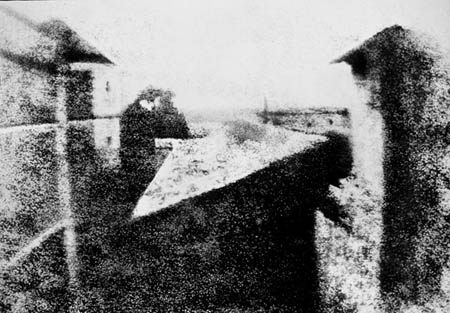
Joseph Nicéphore Niépce produces the first photograph using the 'Heliography' technique. This can be seen as a precursor to digital art in that it represents the first instance of an image created/captured by means of the mechanical (ie the camera)(although some could argue that the ball point pen was the very first as a prosthetic extension of the arm).
1900-1930
1926: Baird's Mechanical Television
Baird invents the mechanical television. It screens only 30 lines of resolution, therefore the image is only just recogniseable. Baird's TV is much taller than wide in contrast with modern TV.
1930-1960
1933: PHONOVISION
File:Http://www.tvdawn.com/images/mrafter.jpg possibly a part of the digital time line because of the nature of the projection; totally mechanical with either light or dark represented/ on or off, one or zero. ???? "BINARY" projection....
1949: CSIR Mk1
File:Http://upload.wikimedia.org/wikipedia/en/f/fb/CSIRAC.jpg CSIRAC (Council for Scientific and Industrial Research Automatic Computer), originally known as CSIR Mk 1, was Australia's first digital computer, and the fourth stored program computer in the world. It is also the world's oldest existing and first to play digital music.[1] (from http://en.wikipedia.org/wiki/CSIRAC)
1957: MUSIC
In 1957 Max Matthews creates MUSIC, the first computer program designed to create music on a digital computer. Later in that year the first performance of music by a digital computer takes place when an IBM 704 performs a 17-second piece of music using the MUSIC program.
1958: First Video Game
Physicist Willy Higinbotham invents the first "video game" at the Brookhaven National Laboratory in Upton, New York. It was table tennis-like game, designed to be played on an oscilloscope. An Oscilloscope is electronic device used to produce visual displays which correspond to electrical signals. The display is formed by a moving dot on the screen of a cathode-ray tube. Usually, horizontal deflecting circuits move the dot in a repetitive cycle from left to right, and then, very quickly, back to its starting position to begin the next sweep. If during this process the vertical deflecting circuits move the dot up and down in response to the variations of the signal to be observed, a wavelike picture of the signal appears on the screen.
1960-1990
1990: Release of Photoshop 1.0
Photoshop is a graphics editor developed and published by Adobe Systems. It has been described as "an industry standard for graphics professionals"
1963: Wolf Vostell, Burying T.V
Vostell created this work in 1963. It involved a Television playing the programme being broadcast at the time. Food as thrown at the T.V, from cake to turkey. The food stuck, thus creating a 'Decolage' which was then covered with a canvas with a small hole in it so that only part of the screen was visible. A barbed wire crown was placed on the T.V then in was buried in a grave. This work is representative of the artists who were questioning the nature of new broadcast media and the impacts this media would have on a wider society. Vostell understood that it would change our way of perceiving the world.
1964: Charles Csuri
In this year Charles Csuri begins experimenting with computer graphics, and is credited with creating the first computer graphic artwork in the same year.
1965: Sony Portapack
Sony Corp. give Nam June Paik the first portable consumer Video Camera, the PortaPack. Paik is possibly the first artist to use a personal Video Camera. Rumor has it he videotaped the Pope on his way home from collecting the camera.
1969: TV as a Creative Medium
Opening in New York at the Howard Wise Gallery it was an exhibition of 12 artists including Ira Schneider, Frank Gilette, Nam June Paik and Paul Ryan. This was the first Show in the U.S devoted entirely to video, and inspired many to take up the medium.
1969: Seek
SEEK is a work which intent was for the visitors to interact with various technological devices, without being asked to consider them as artworks. It was created by Nicholas Negroponte and his colleagues at MIT’s Architectural Machine Group. It was AI-inspired programming effort that hardly reached its goals, except on metaphorical level. Living gerbils were placed on a glass-caged arena with aluminium building blocks and a pre-programed computer controlled robot arm operating from above. The system, engaged in arranging the blocks, it was supposed to respond “intelligently” to the noise made by the gerbils, bumping and moving the blocks.
1969: Videoplace
Myron Krueger is the artist behind this pioneering work of virtual reality. The installation features computer projection which interacts with the viewers shadow.
1969: ARPANET
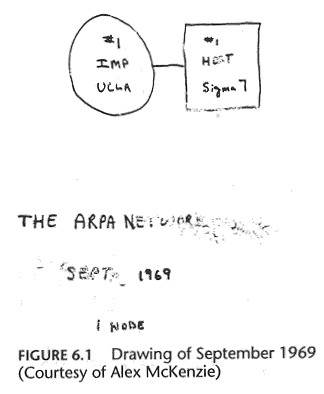
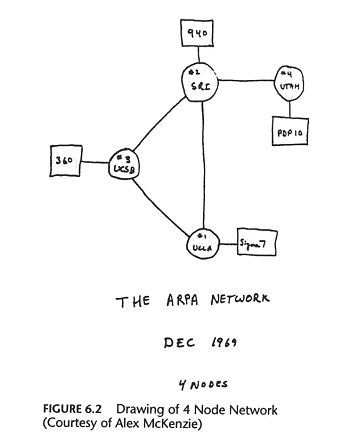
ARPANET comes into action. Invented by Lick Licklider and Lawrence Roberts amoung others APRANET is the first being of a computer network. These ideas have evolved into the internet of today and were originally designed to connect Universities so they could communicate and share research information. APRANET info
1973: Nam June Paik, Global Grove
"This is a glimpse of a video landscape of tomorrow when you will be able to switch on any tv station on the earth and tv guides will be as fat as the Manhattan telephone book" Paiks theorys worked with the technology of tv to create a different way of looking at the implications it would have on society.
1975: Media Burn-Ant Farm
Biggest attack on media at the time, footage of burning tv sets being hit by a cadillac created from all the major media stations in America.
1977: Dave Jones audio visualizers
http://www.audiovisualizers.com/toolshak/vidsynth/djones/frbuff.jpg
Dave Jones explored early digital video processing techniques through design work at the E.T.C. & in April 1977 he created the 64 by 64 frame buffer, which stores images as a pattern of64 horizontal by 64 vertical squares, with a choice of 16 grey lcvels per square. The cost of memory and analog to digital conversion limited the number of grey levels and resolution. These limitations yielded a video image meshed into a charming box-like grid of intensity, that is frozen or held under front panel control. A 4 bit, 16 level video-speed Analog to Digital Converter, samples the monochrome video input. This is fed to a 4K by 4 bit static Random Access Memory (RAM), where it is held on command by a front panel push button, locked to the vertical interval. The output of the frame buffer memory passes to the output Digital to Analog converter, changing the video signal back to its analog form. When running "live" the image bypasses the frame buffer memory, passing straight to output. When "frozen," the image is pulled from the frame buffer, showing the last stored picture. A horizontally / vertically locked address counter supplies the timing for the memory. A later addition allowed coutrol of the write pulse by an external signal, developing a coarse keying between the stored and live image. The coarse "mosaic" and 1 6 level contouring of vodep intensity are components of image style seen in the 64 by 64 buffer. (taken from http://www.audiovisualizers.com/toolshak/vidsynth/djones/djones.htm)
1978: Mandelbrot Set
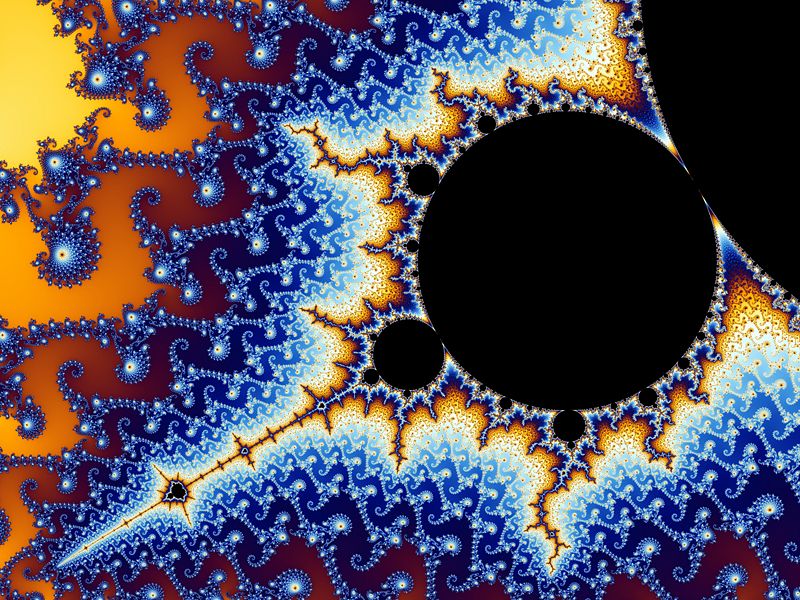
Benoît B. Mandelbrot, PhD, (November 20, 1924 -14 October 2010) was a French-Jewish-American mathematician, best known as the "father of fractal geometry". The Mandelbrot set is a set of points in the complex plane, the boundary of which forms a fractal. It has it's place in complex dynamics, a field first investigated by the French mathematicians Pierre Fatou and Gaston Julia at the beginning of the 20th century. The first pictures of it were drawn in 1978 by Robert Brooks and Peter Matelski as part of a study of Kleinian Groups. One significant way of creating digital art is by utilising fractals. It is very popular and can be created in many different ways, see "Electric Sheep" below as one example.
1978-79: Dara Birnbaum Technology Transformation
http://www.medienkunstnetz.de/assets/img/data/3092/bild.jpg
Dara Birnbaum creates Technology/Trasformation which is a deconstructrion of the idealogy embedded in television. Appropriating footage from the popular TV series Wonder Woman, Birnbaum essentially manipulates the content to emphasize the transition of woman to 'superhero.' Despite what may appear to be a re-shoot of footage for Birnbaum's particualar work, it is widely believed that all she has done in order to create her work is to fragment and repeat certain elements. Birnbaum has essentailly 'cut and paste' pieces together from the original footage used in the television show. The underlying theme? Reality becomes wonder in a psychological transformation vs. televised context. http://www.eai.org/eai/tape.jsp?itemID=1673
1979: Len Lye, Particles in Space.
This work involved Lye scratching into the surface of film and creating sound to accompany the movements of the scratches. Lye's technique was both painstaking and revolutionary. This analog technique has been the precursor to many more analog and digital artworks.
1980's: Goodnight Kiwi
adds played when tvnz shut down for the night.
1983: Founding of Wacom Co., Ltd.
Wacom is a world-wide company that produces graphics tablets and related products. It is one of the largest graphics tablet producers and is very popular with artists, graphic designers, architects, and cartoonists. Wacom tablets are notable for their use with a patented cordless, battery-free, and pressure-sensitive stylus (an on-screen writing pen).
1984: "Good Morning Mr. Orwell"
A global (well northern hemisphere at least) television broadcast that took place at 12pm, Jan 1 1984. Designed by Nam June Paik and meant to be seen around the world. It also bought several different performances together at once form multiple locations. For example something filmed in New York would be mixed, picture in picture style, with something from Europe and broadcast 'globally'. Paik was interested in the sense of connection that this sort of broadcast could create and the ideas of human to human interaction across such a medium as broadcast television. Many of the things filmed were tied into the ideas surrounding Orwell's ideas about Big Brother and constant surveillance and totalitarian control. eg, Beauy's piece about 'Big Brother Trousers'.
1986: Dawkin's Biomorphs
In support of his ideas in the book on evolutionary biology 'The Blind Watchmaker', Richard Dawkins created a computer program called 'Biomorphs' to demonstrate ideas about natural selection. The user is able to shape an image by selecting their favourite image from a set of eight, the act of which would produce a new set of images to chose from. This program is important to digital art as it helped to inspire evolutionary artists, such as Karl Sims, William Latham and Steven Rooke. An version of the program can be found here: http://www.well.com/~hernan/biomorphs/biomorphs.html
1987-88: Stan Douglas, T.V. Spots
Douglas' work looks at the way in which we watch and absorb tv and the messages it carries.He creates simple narrative works that force us to question the way he process what we see and hear when we watch media tv and played this work through really media settings.
1990-2010
1990: 3d studio Dos released.
The predecessor to 3d studio max
1992: Michael Benedikt Cyberspace
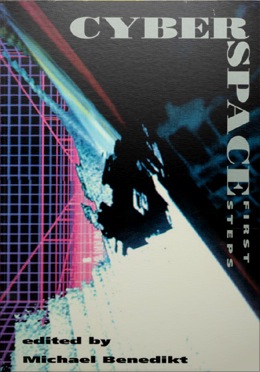
Michael L. Benedikt publishes 'Cyberspace: First Steps' a highly influential book composed of contributions from various sources. The book philosophically examines various aspects and implications stemming from the idea of cyberspace, many of which had previously been unpublished at that time and was proceeded by an influx of publications about cyberspace and its nature in contemporary culture. MIT Press
1994: The World's First Collaborative Sentence.
Douglas Davies (& internet participants)- The World's First Collaborative Sentence. This is an ongoing collaborative work, which initially only supported text, now hosts multimedia entries. International and seemingly endless, this project is often described as an emblem of internet aesthetics.
1995: net.art
December 1995, The term NET.ART is accidentally coined when artist Vuk Cosic opens an email that had been illegibly scrambled in transmission. The term NET.ART was the only piece of legible writing in a mass of code. Cosic began to use this term to describe online art and communication. It is now the term used broadly to cover a massive range of media and ideas that extend to cover much of what is created on, with and shared through the internet, email and other methods of exchange of information, ideas, theory's, images and text. Greene, Rachel. Web Work a History of Internet Art in Art Forum, May 2000
1995: Formation of the Algorists
Jean-Pierre Hébert and Roman Verostko found the Algorists, a group of artists dedicated to creating digital art through the use of algorithms, an algorithm being essentially a prepared recipe for the creation of an artwork. Unlike similar techniques such as Fractal Art, the algorithm must unique and created by the artist.
1996: Denis Beaubois "amnesia"
A three week performance that began by standing in front of surveillance cameras around the city of Sydney. Beaubois would come with signs, saying 'you are being photographed while reading this sign'. This work was documented by a still photographer and a video camera.
1996: Rhizome
This is a thriving nonprofit website which first started off as as an emailing list for artists. Rhizome is important for digital art as it has helped artists that are engaged with the Internet and technology. [1]
1996: Flash 01 launched.
in December of 1996, Macromedia acquired the company and Future Splash Animator became Macromedia Flash 1.0.
1996-2006- Surveillance Camera Players.
The surveillance Camera Players are a group of artists who use the CCTV cameras operating in public spaces to create video and photographic works. They hold up signs that question the nature of the systems in place to watch us and perform in many ways to the cameras. They then attempt to recover the footage they are captured in to spread their work. These artists are a great example of people using the controlling infrastructure that surrounds us in our society to undermine it and ask questions of a submissive and complacent public.
1996: 3d studio max released
was officially announced at Siggraph 1995 and shipped to users in April 1996.
1998: December, first Dunedin Electronica Album
Variant 386 released Dunedin's first entirely computer loop based album of electronic music, entitled 'Techgnosis' http:www.variantmedia.co.nz/techgnosis.html
1998-2000
Darko Maver, a project from the duo 0100101110101101.ORG, a completely fictional artist created between 1998 and 2000 when the reality was revealed to the world. 0100101110101101.ORG completely managed to manipulate the internet in order to create not only an artist but also a body of work, a personal history and detailed account of his activities. This seems important to me because of the massive response to this creation of a 'fake'. The power of the Internet and computers (for the creation of faked media reports, bio's, artworks etc) was revealed and created heated debate as archived at http://0100101110101101.org/home/darko_maver/story.html
1998: One Tree- Natalie Jeremijenko
1000 clones of the same tree were micro-propagated in culture. After two years they were planted in two-hundred public locations in the San Francisco Bay area. Over time the exhibit changes based on the environmental and social circumstances.
1999: Electric Sheep
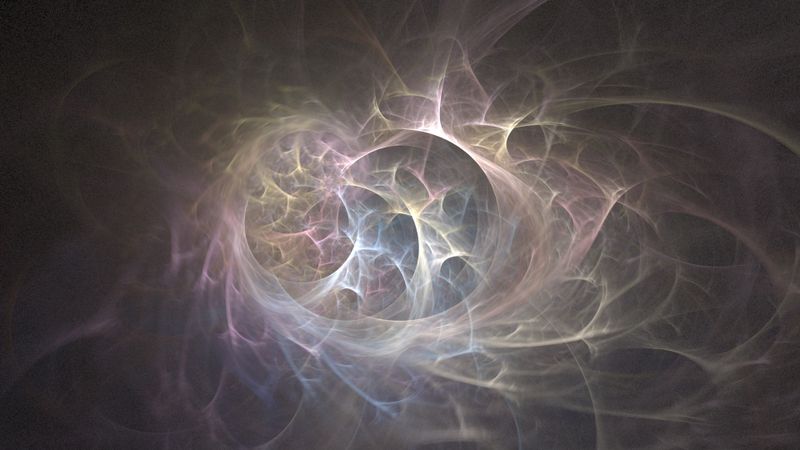
Electric Sheep is a distributed computing project for animating and evolving fractal flames, which are in turn distributed to the networked computers, which display them as a screensaver on the individual node computers of the distributed network. The process is transparent to the casual user, who can simply install the software as a screensaver. Alternately, the user may become more involved with the project, manually creating sheep (video files of animated fractal flames) for upload to the server. The screensaver was created and released as Free Software by Scott Draves in 1999 and continues to be developed by him and a team of about five engineers. It is an example of creating digital art by using a mathematical process. Fractal art is interesting in that it is one of the ways that people can work together with computers to create art. This "symbiosis" is an exciting concept and raises interesting issues.
2000 (approx.): Processing
This site is based on using open source programming language. It is for people who want to program images, animation, and interactions. It is created to teach fundamentals of computer programming within a visual context. Interesting digital artworks have been created in this environment. This is another example of a way to create digital art by working together with a computer so complete creative control does not fully reside with the person creating the work. [2]
2001 January: Wikipedia launched.
Launched in January 2001 by Jimmy Wales and Larry Sanger, it is the largest, fastest-growing and most popular general reference work currently available on the Internet
2001: Human Genome Sequenced.
Craig Venter attributed the achievement of the first 'complete' sequencing of the human genome opening the way for the understanding of the genetic codes and hence thier artificial manipulation.
2001: 0100101110101101.org at Venice
6th June 2001. An Italian NET.ART collective, known as 0100101110101101.ORG, 'release' a computer virus called Biennale.py at the 49th Venice Biennale. The virus quickly catches the attention of the media gathered for the Bieannale and quickly blows up into a massive and controversial event. It also fulfills 0100101110101101.ORG's goals about the way in which media hysteria can be hyped and provoked. Debate over whether something destructive, like a computer virus, can exist simultanesouly as art is still relevant today.
2001: Black Shoals
The idea of List Autogena and Joshua Portway, and first exhibited at the Tate gallery, Black Shoals is a 'Stock Market Planetarium', a live representation of the world stock market in the form of a sky at night. Each star represents a trading company, and the more that the companies stock is traded, the brighter its star glows. In addition to the stars the representation is also inhabited by artificial life forms, who feed off of the glow of the stars. An more sophisticated version was exhibited in Copenhagen in 2004
2002: Douglas Bagnall Javascript chess
Douglas Bagnall writes the first ever smallest Javascript Chess game for the 5k competition. At this time it is the smallest chess game available on the internet, and functions sufficiently as a game. It is able to explore all possible moves, while keeping score along the way. Since then many artists have challenged Bagnall's minimal chess game to come up with better file compression, and more detailed imaging. Have a go yourself! [3]
2003: launch of second life
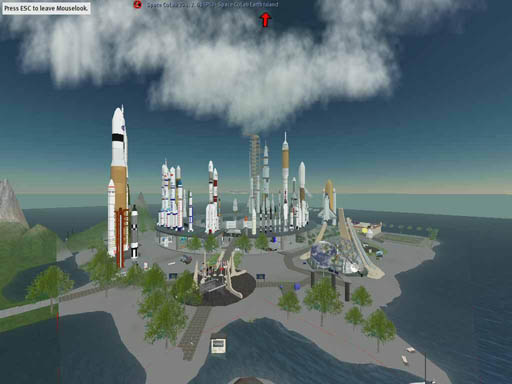
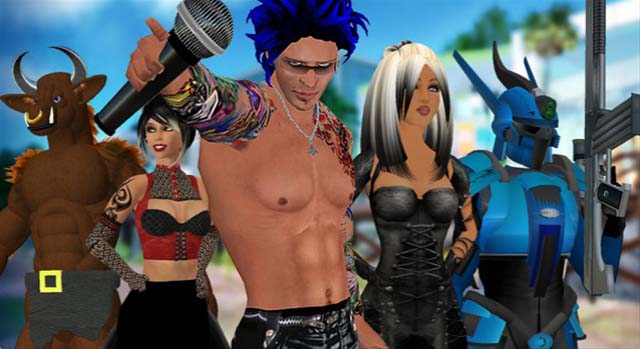
SecondLife opens to the public. Positioned as a '3d virtual world created entirely by its residents' second life gives people an opportunity to create an entire alternate identitiy and online life within which only real participants operate and real money can exchange hands. It functions under its own economy and theoretically gives everyone with access to a fast enough computer (internet) a chance to participate in this online community. This also opens up new artistic opportunities and an creates interesting new genre with blogs and websites opening up devoted directly towards and from 'players' of this virtual world. SecondLife
2004: Eyebeam
[4] Eyebeam is a website that incubates "cutting-edge" digital art. It also provides state-of-the-art tools for digital research and experimentation. Eyebeam is designed to be educating, challenging convention, addressing issues, free and open. Joseph DeLappe is an example of an Eyebeam artist and here are two examples of his current work:
Joseph DeLappe will enact his ongoing protest and memorial work set within the U.S. Defense Department’s online military recruiting and marketing video game, America’s Army. Using the login name “dead-in-Iraq”, DeLappe enters the multiplayer game as a player and, forgoing fighting, uses the game’s features to memorialize US military members killed in Iraq.
Over a period of 26 days from 12 – 6PM, using a treadmill customized for cyberspace, Joseph DeLappe will reenact Mahatma Gandhi’s famous 1930s Salt March, a 240-mile protest in response to the British salt tax, live and in Second Life, the Internet-based virtual world. For this performance, DeLappe will be physically walking on a converted treadmill the entire 240 miles of the original march. His steps on the treadmill, which will control the forward movement of his avatar in the online world, will both be physically and virtually reenacting this seminal march of protest.
2004: Douglas Bagnall Film-making Robot
Douglas Bagnall, Set up surveillance on Wellington bus routes "computer recognition of intangable properties through the use of tangled feedback loops". Made the 'robot' do the editing by setting it so it saw the footage in stills and made the video of series of stills it saw with similarities.
Nov, 23rd 2004: Blizzard - Launch of World of Warcraft
World of Warcraft (commonly known as WoW) is a massively multiplayer online role-playing game (MMORPG). It is frequently referenced in popular culture. Similar to Second Life, you create an entire alternate identitiy in WoW within difference race and classes. It has it's own economy and exchange system in the real world.
2005: Steve Chen, Chad Hurley and Jawed Karim. Youtube.
In 2005 these artists saw the demand for an online forum which people could post their videos to. Youtube has now become the fourth most visited website online. It has become an icon of popular culture and a way for people to share information, ideas, art and whatever they want to create. Love it, hate it. Contribute.
2006: Raphal Lozano-Hemmer Homographies
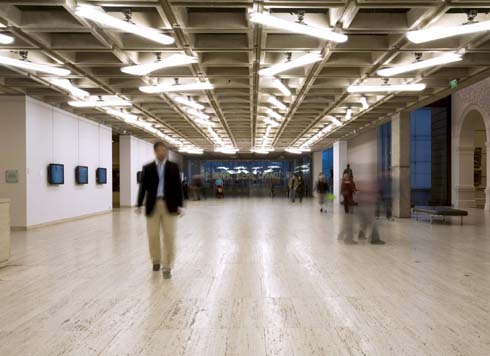
Raphal Lozano-Hemmer is invited to the 2006 Sydney Biennale where he installs a work called 'Homographies.' He intalls a grid of rotating neon lights in the central corridor of the Art Gallery of NSW. These are connected to a series of sensors and survellance cameras which sence peoples movement throughout the space and in turn control the movement of the various rotating lights. Also a computerised diagram of people moving through the space (shown as dots) and the action/reaction of the lights is shown in real time on a screen (as well as some survellence footage). The result creates 'a reconfigurable light-space that is based on flow, on motion, on lines of sight' and gives the veiwer an acute awareness that they are being monitored as they move through the reactionary architectural space. Also possibly showing new directions for architecture. Homographies
2007: Ustream.tv.
Established March 2007, Ustream.tv is a website which consists of network of diverse channels providing a platform for lifecasting and live video streaming of events online. It's similar to youtube but instead of posting videos they're streaming live.
2007: Mark Owens, Avatar Machine.
Mark Owens created a machine that allows the person wearing it to see themselves from a third person perspective in real time as the move through life. Essentially allowing a person to be their own avatar as they would create in online gaming. This work highlights the immersion in the internet that we experience in our everyday life. We have shifted from wanting to replicate real life online, to wanting to replicate the web in our real life.
2007: Seam carving for content-aware image resizing.
Seam carving is an algorithm for image resizing (primarily shrinking) developed by Shai Avidan and Ariel Shamir. With this technique, it's now possible to scale pictures by a large amount, while still retaining details. In normal Image scaling, scale factors greater than 2 or less than 0.5 usually result in visible image quality degradation. http://www.youtube.com/watch?v=vIFCV2spKtg
2008: Synthetic organisms
In early 2008, scientists at the J. Craig Venter Institute announced that they had manufactured the entire genome of a bacterium by painstakingly stitching together its chemical components. By sequencing a genome, scientists can begin to custom-design bootable organisms, creating biological robots that can produce from scratch chemicals humans can use, such as biofuel. (retrieved from: http://www.ted.com/speakers/view/id/7 20/03/08)
February 2008: the geekosystem
[5]The geekosystem, Physics Room Gallery, Christchurch. Adam Hyde, Julian Priest and David Merritt.
March 2008: Wafaa Bilal show censored
http://youtube.com/results?search_query=Wafaa+Bilal&search_type=
info: "Iraqi-born Chicago-based artist Wafaa Bilal interviewed after his show called Virtual Jihadi at Rensselaer Polytechnic Institute was "suspended" and he was shut out of the arts building. The art piece consists of a hacked video Al Qaeda video game called Night of Bush Hunting. The artist inserted himself as a virtual suicide bomber as a way of referencing his own anger and despair over his brother and father's death during the American occupation as well as the anger and despair of Iraqis who have lost control of their lives."
March 2008: World TV
is about to be launched: [6] http://worldtv.com here's the announcement:
this is their pitch:
"With WorldTV you'll be able to search for and watch millions of video clips from around the World, and add them easily to your own full screen, web video channel. You'll even get your own TV Channel logo and a cool WorldTV URL (eg worldtv.com/alxtv) where you can invite others to come see what you've compiled. How you use it is up to you. You could create a themed channel on a specific subject, or a collection of different material that you simply like. With WorldTV, you get to be the media baron!"
March 2008: TV Art for the Digital Generation
"California Video", an art exhibition showcasing a huge range of digital artists opens this week at Los Angeles' Getty Centre. The exhibtion claims to the first of its kind in the west coast of the US, featuring over 50 single channel videos and 15 installations.http://media.www.daily49er.com/media/storage/paper1042/news/2008/03/18/Diversions/Tv.Art.For.The.Digital.Generation-3272905.shtml
